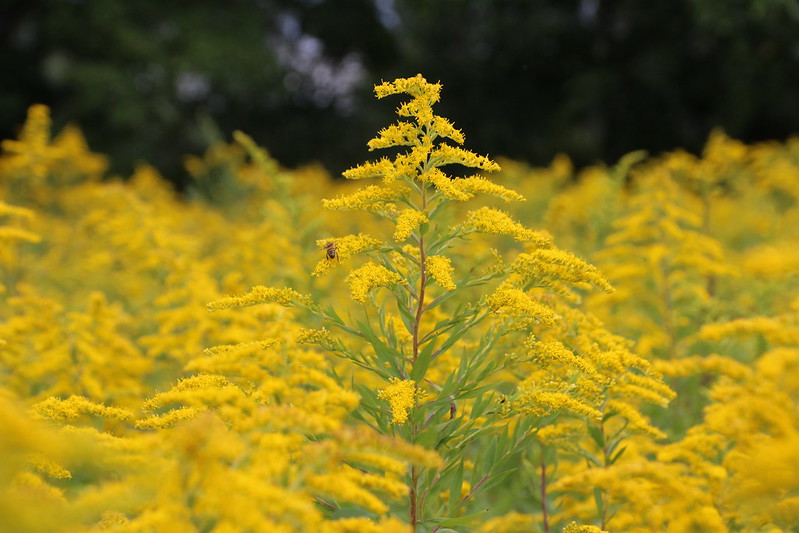The first splashes of fall color don’t come from the trees. They come from the flowers. Local fields are full of yellows, purples, and whites as fall flowers bloom in full force. Some look at these fields as full of weeds, but I look out on a field of goldenrod and asters as an important building block in our local ecosystem.
Many people are conditioned to see fields of flowers as something that causes allergies, but that is mostly not true. Allergies are generally caused by pollen blown in the wind from trees and grass in the spring and summer, and from ragweed in the fall. The heavy pollen of goldenrod is carried by bees and, unless a bee flies up your nose covered with pollen, you are not likely to come in contact with it away from the plant.

There are many fall flowers blooming now, but let’s look at goldenrod first. It’s one of those irritating plants that is easy to recognize and hard to identify. The flowers are usually a bright yellow, so easily recognized that you can find crayons and paper labeled as goldenrod in color. The leaves have a distinct smell when you rub them that I can only describe as “goldenrod”. It is sweet and musty and sour.
Saying it is a goldenrod is fairly easy. Identifying it is a different problem. There are at least 38 species found in New York alone and over 100 species continent-wide. The keys to identify goldenrod quickly force people into becoming very observant and very patient. There are a lot of tiny things that distinguish one plant from another and I have discovered that I don’t care enough about them. My interest is more with what they do.
Goldenrod fields are chock full of pollen and nectar. Monarch butterflies fuel up there as they migrate to Mexico. Goldenrod is usually covered with a variety of butterflies and bees. Honeybees gather food from goldenrod to store honey and pollen for the long winter months. Bumblebees clumsily drink from the flowers, their long black tongues stabbing down. Ants swarm up the stems to gather pollen. Goldenrod feeds a hidden nation of insects that we rarely glimpse.

I have to confess that I find staring at goldenrod to be fascinating. Goldenrod is bursting with life. Pennsylvania Leatherwings are long beetles with distinct orange and black bodies that have the textured look of leather. These beetles dine on pollen, but their velvety black larva eat aphids and other insects. Tree crickets crawl along, dining on pollen. Locust Borers are beetles that resemble wasps with zig zag yellow stripes. They eat goldenrod pollen as adults, but their larva burrow into locust trees and tunnel through the wood.
Goldenrod is visited by wasps of all shapes, colors, and sizes. These predators are sometimes searching for insect prey in the leaves and sometimes grabbing a drink of nectar from the flowers.
One of the most stunning local caterpillars, the Brown-hooded Owlet, loves to eat goldenrod. Its tiny red, blue, yellow, and black body looks more like a cartoon than a living thing.
I didn’t set out to write an article on how amazing goldenrod is, but it happened. The truth is, the more I wrote, the more I remembered. I can remember whacking my sisters with the round ball galls formed in the stem of goldenrod by the Goldenrod Gall Fly and giving one to my baby to teeth on while hiking. We matted the goldenrod down in the field as kids to create rooms. As an adult, there are so many times that goldenrod has caused me to pause and stare at some insect I have never seen or a bird dining on winter seeds.
The truth is, goldenrod is vitally important to animals in our area. There are numerous insects that only eat goldenrod leaves or stems. The flowers fuel butterfly migration and bee survival. The winter seeds feed birds all winter long. The stems provide a good place for many native bees to lay their eggs. There is not enough time to talk about the awesome power of goldenrod.
Goldenrod can easily spread and become a nuisance. In fact, goldenrod is an invasive plant in Europe and other parts of the world that is hard to control. In my yard, I let it grow amongst the raspberries and in a patch along the shed. It attracts bees, butterflies, and moths to the yard that might never visit otherwise.
If you have a few minutes to spare, come out to Audubon and check out the fields of goldenrod and explore the life that is on them. If you can’t get to Audubon, look around your neighborhood. Chances are, there are a few plants growing up someplace nearby that are filled with life.
That is what goldenrod does, it creates a perfect storm of nectar, pollen, seeds and leaves to sustain life in our region. It deserves some respect.
Audubon Community Nature Center builds and nurtures connections between people and nature. ACNC is located just east of Route 62 between Warren and Jamestown. The trails are still open from dawn to dusk as is Liberty, the Bald Eagle. The Nature Center is partially open, including restrooms, the Blue Heron Gift Shop, and some exhibits. More information can be found online at auduboncnc.org or by calling (716) 569-2345.


Recent Comments